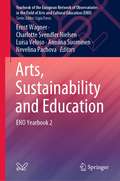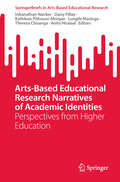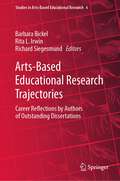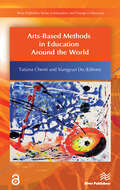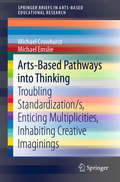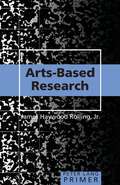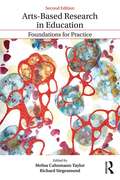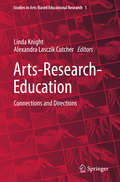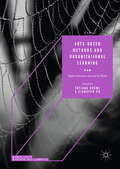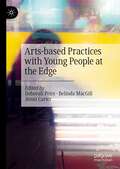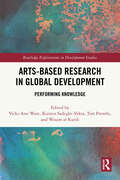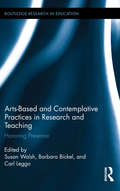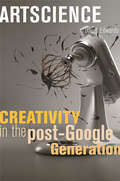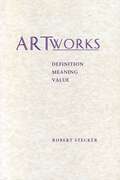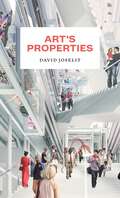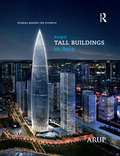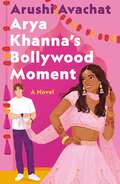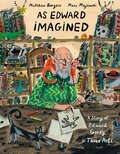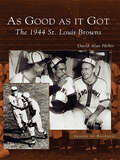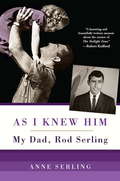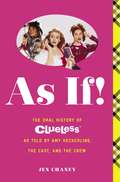- Table View
- List View
Arts, Sustainability and Education: ENO Yearbook 2 (Yearbook of the European Network of Observatories in the Field of Arts and Cultural Education (ENO))
by Luísa Veloso Charlotte Svendler Nielsen Ernst Wagner Anniina Suominen Nevelina PachovaThis book explores the potential of arts and cultural education to contribute to on-going efforts to promote Education for Sustainable Development (ESD) in line with UNESCO’s conceptualizations of the field. It builds on the experiences of arts educators working to build sustainable futures and portrays new and innovative approaches. Chapters comprise case studies that combine arts, culture, sustainable thinking and practices. They also include research from historical perspectives, evaluations of public policy measures and offer theoretical approaches and methodologies. The book unfolds the possible relationships between arts and cultural education and Education for Sustainable Development.
Arts-Based Educational Research Narratives of Academic Identities: Perspectives from Higher Education (SpringerBriefs in Arts-Based Educational Research)
by Kathleen Pithouse-Morgan Daisy Pillay Inbanathan Naicker Lungile Masinga Theresa Chisanga Anita HiralaalThis book delves into the complexities of being and becoming an academic in higher education. Inspired by the arts, the book introduces new voices and insights to scholarly discussions about what constitutes data and analysis in higher education research. It demonstrates ABER’s ability to shape and critique academic identity narratives in response to pressing problems and dilemmas in higher education. The book includes exemplars from studies conducted primarily in South African contexts and led by South African researchers. It explores diverse modes, including collage, digital artwork, letter writing, metaphor, creative nonfiction, and theatre-making. Contributions from expert scholars in Canada and the USA supplement this research and show how it has been enriched by critical transcontinental conversations. The authors offer new perspectives on the entwined and complex relationship between the ABER, narratives, and identities.
Arts-Based Educational Research Trajectories: Career Reflections by Authors of Outstanding Dissertations (Studies in Arts-Based Educational Research #6)
by Rita L. Irwin Richard Siegesmund Barbara BickelThis book offers reflections from Arts-Based Educational Research (ABER) scholars who, since 2005, were awarded the American Educational Research Association ABER Special Interest Group's Outstanding Dissertation Award. The book includes essays from ten awardees who, across diverse artistic disciplines, share how their ABER careers evolve and succeed—inspiring insights into the possibilities of ABER. It also examines the essential role of mentorship in the academy that supports and expands ABER scholarship. Drawing from dissertation exemplars in the field, this book allows readers to look at how ABER scholars learn with the world while creatively researching and teaching in innovative ways
Arts-Based Interventions and Social Change in Europe (Routledge Advances in Art and Visual Studies)
by Andrea KárpátiThis book presents 23 successful arts-based efforts to respond to social problems experienced by disadvantaged communities. The arts are a powerful means of fighting discrimination, marginalisation, neglect and even poverty. The educational programmes described in these chapters help stakeholders find solutions which are research-based, adaptable, repeatable and sustainable. Social problems that are addressed in this book include children living with physical challenges; suffering from financial and educational poverty; elderly women suffering from solitude; migrants facing a strange and not always welcoming cultural context; Roma youth fighting negative stereotypes and many more. Revealing the interconnectedness between social, economic and cultural exclusion, contributors planned interventions to develop skills, strengthen identities and build communities. This book will be of interest to scholars working in the visual arts, art education, design education, drama and theatre education and museum pedagogy. The Open Access version of this book, available at http://www.taylorfrancis.com, has been made available under a Creative Commons [Attribution-Non Commercial-No Derivatives (CC-BY-NC-ND)] 4.0 license.
Arts-Based Methods for Research with Children (Studies in Childhood and Youth)
by Anna Hickey-Moody Christine Horn Marissa Willcox Eloise FlorenceThis book offers a practical, methodological guide to conducting arts-based research with children by drawing on five years of the authors’ experience carrying out arts-based research with children in Australia and the UK. Based on the Australian Research Council-funded Interfaith Childhoods project, the authors describe methods of engaging communities and making data with children that foreground children’s experiences and worldviews through making, being with, and viewing art. Framing these methods of doing, seeing, being, and believing through art as modes of understanding children’s strategies for negotiating personal identities and values, this book explores the value of arts-based research as a means of obtaining complex information about children’s life worlds that can be difficult to express verbally.
Arts-Based Methods in Education Around the World: Higher Education Around The World (River Publishers Series In Innovation And Change In Education Ser.)
by Tatiana Chemi Xiangyun DuArts-Based Methods in Education Around the World aims to investigate arts-based encounters in educational settings in response to a global need for studies that connect the cultural, inter-cultural, cross-cultural, and global elements of arts-based methods in education. In this extraordinary collection, contributions are collected from experts all over the world and involve a multiplicity of arts genres and traditions. These contributions bring together diverse cultural and educational perspectives and include a large variety of artistic genres and research methodologies.The topics covered in the book range from policies to pedagogies, from social impact to philosophical conceptualisations. They are informative on specific topics, but also offer a clear monitoring of the ways in which the general attention to the arts in education evolves through time.
Arts-Based Pathways into Thinking: Troubling Standardization/s, Enticing Multiplicities, Inhabiting Creative Imaginings (SpringerBriefs in Arts-Based Educational Research)
by Michael Crowhurst Michael EmslieThis book, based on a critical/collective/auto/ethnographic research project, describes an assemblage of theoretically informed, arts-based methods that aim to promote multiplicity and thinking. It explores multiplicities of knowing, sensing, doing and being, generated by analyzing knowing frames, poetry, reading aloud, fableing, playwriting and other inventive, playful and scholarly ways of working with experiences and stories. By offering engaging and inspiring strategies that can disturb standardizations and interrupt cultural normativities, the book sheds light on the conditions that might be present in cultural contexts that enable diversity and creativity. The research project on which this book is based originated from a contradictory set of conditions characterized on the one hand by a marked interest in creative research methods and novel knowledge practices and, on the other hand, by a widespread concern that we live in increasingly standardized times, featuring systems that specify objectives ahead of time, demand compliance and narrow the possibilities for human action. The book takes readers on an arts-based journey designed to enhance the opportunities for imaginative and ethical professional practice in education, human services and the arts.
Arts-Based Research Primer (Peter Lang Primer #36)
by James Haywood Rolling<p>The Arts-Based Research Primer explores the arts-based research paradigm and its potential to intersect with and augment traditional social science and educational research methods. The arts-based research (ABR) paradigm may be broadly understood as a flexible architecture of practice-based theory-building methodologies. This text aims to reveal how arts-based ways of knowing and doing lend themselves to blended spaces of naturalistic inquiry, and is intended to aid artists and scientists alike in their research and professional practices. <p>This text also highlights the utility of arts-based research concepts toward building innovative curriculum-making strategies for educational practice both within and beyond the classroom setting. Accessible examples of analytic, synthetic, critical-activist, and improvisational arts-based research methodologies and their outcomes were solicited from a wide range of researchers in varying disciplines, including senior faculty and emerging graduate level scholars. Chapters include a paradigm analysis of the characteristics of arts-based research; brief historical overviews along with a review of recent ABR literature; charts, diagrams and photographs representing ABR approaches for addressing diverse kinds of questions; suggestions for using an ABR inquiry model when writing a research paper; and detailed glossaries of key concepts and terms.</p>
Arts-Based Research in Education: Foundations for Practice (Inquiry And Pedagogy Across Diverse Contexts Ser.)
by Melisa Cahnmann-Taylor Richard SiegesmundPresenting readers with definitions and examples of arts-based educational research, this text identifies tensions, questions, and models in the field and provides guidance for both beginning and more experienced practice. As arts-based research grows in prominence and popularity across education and the social sciences, the barriers between empirical, institutional, and artistic research diminish and new opportunities emerge for discussion, consideration, and reflection. This book responds to an ever increasing, global need to understand and navigate this evolving domain of research. Featuring a diverse range of contributors, this text weaves together critical essays about arts-based research in the literary, visual, and performing arts with examples of excellence in theory and practice. New to the Second Edition: Additional focus on the historical and theoretical foundations of arts-based educational research to guide readers through development of the field since its inception. New voices and chapters on a variety of artistic genres, including established and emerging social science researchers and artists who act, sing, draw, and narrate findings. Extends and refines the concept of scholartistry, introduced in the first edition, to interrogate excellence in educational inquiry and artistic processes and products. Integrates and applies theoretical frameworks such as sociocultural theory, new materialsm, and critical pedagogy to create interdisciplinary connections. Expanded toolkit for scholartists to inspire creativity, questioning, and risk-taking in research and the arts.
Arts-Based Research, Resilience and Well-being Across the Lifespan
by Susanne Garvis Georgina Barton Loraine McKay Viviana SappaThis book investigates how arts-based research methods can positively influence people’s resilience and well-being, particularly in constraining environments. Using examples from arts-based research methods in different contexts and from across the globe, the book brings together a diverse range of perspectives to understand how both resilience and well-being can be supported in a world that is rarely stress free. Collectively they demonstrate how arts-based research methods can: provide agency through the foregrounding of participants’ voices; afford transformational learning opportunities; create opportunities for relationship building; support creativity and new ways of thinking; generate aspirations and hope; encourage forms of communication that expose ideas, emotions and feelings that previously might not have been known or known how to be expressed; and enhance reflection and reflexivity. The authors explore how art-based practices, such as clowning, collage, dramatisation, drawing, painting, role-play and sculpting, can be used to support the resilience and well-being of individuals and groups across the lifespan, and theorize how arts-based research methods can positively contribute to participants’ positive self-esteem, self-image and ability to cope with challenges and new circumstances. Academics, professional learning facilitators, higher education students, and anyone interested in resilience and well-being in the health and education sectors will find this an interesting and engaging text.
Arts-Research-Education: Connections and Directions (Studies in Arts-Based Educational Research #1)
by Linda Knight Alexandra Lasczik CutcherDrawing from an international authorship and having global appeal, this book scrutinizes, suggests and aggravates the relationships, boundaries and connections between arts, research and education in various contexts. Building upon existing publications in the field of arts-based educational research, it deliberately connects and disconnects the terms in order to expose and broaden the scope of this field thereby encouraging fresh perspectives. This book portrays both contemporary theoretical prospects as well as contemporary examples of practice. It also presents work of emerging scholars, thereby 'growing the field'. The book includes academic text-based chapters, as well as poetry, narrative fiction, visual essays, and combinations of text-image-sound/video that demonstrate performance of music, theatre, exhibition and dance. This book provides and provokes critical dialogue about the forms, representations, dissemination and intersections of the arts, research and education. This is a focused collection and resource for scholars and students with an international authorship, perspective and audience.
Arts-based Methods and Organizational Learning: Higher Education Around the World (Palgrave Studies in Business, Arts and Humanities)
by Tatiana Chemi Xiangyun DuThis thematic volume explores the relationship between the arts and learning in various educational contexts and across cultures, but with a focus on higher education and organizational learning. Arts-based interventions are at the heart of this volume, which addresses how they are conceived, designed, carried out, and assessed in different higher educational and cultural contexts. Readers will discover diverse perspectives of the contributing authors from across the world and from a variety of settings: formal education, informal learning for adults and organisational learning. A necessary introductory conceptualisation sets the stage for the discussion of the different cases, with chapters presented according to the art forms the address: performing arts, dance, music, language arts, visual arts, multi-arts and a conclusive chapter on future perspectives for arts-based educational approaches. Arts-based Methods and Organisational Learning: Higher Education Around the World will inspire and inform both scholars and practitioners who are dealing with the arts in education and organisations.
Arts-based Practices with Young People at the Edge
by Deborah Price Jenni Carter Belinda MacGillThis book explores how arts-based programs designed to reconnect young people with learning and work provide brief, sometimes profound, re-engagements and productive identity shifts. It aims to support youth pushed to the edge of formal education and entangled in structural social and cultural inequality. The researchers, artists, activists, and youth organizations developed process-oriented practices with young people, enacting new creative methodologies building on agentive possibilities to disrupt misrepresentation and invisibility. The book positions arts-based practices at the edge, examining complex systemic issues around youth disengagement and possibilities of collective creativity to navigate broken systems and inform futures. Enacting arts-based methodologies with young people at the edge through co-design shares navigation out of locked trajectories in collaboration with those who listen deeply as allies in their journey of re-presenting themselves to the world. The final section reflects on arts-based practices at the edge eliciting standpoints of young people at the edge.https://link.springer.com/
Arts-based Research in Global Development: Performing Knowledge (Routledge Explorations in Development Studies)
by Tim Prentki Kirsten Sadeghi-Yekta Vicki-Ann Ware Wasim Al KurdiThis book brings together a range of arts and development scholars and practitioners to explore the unique ways in which arts-based research methods can make a unique positive contribution to effective global development practice.Since the 1970s, global development has witnessed an increase in the use of participatory approaches to enable the world’s most excluded peoples to be actively involved in the planning and implementation of development projects that impact them. A range of participatory practices are now in common use, many of which use visual activities which enable fuller participation irrespective of literacy levels or social position. More recently, development practitioners with arts skills, along with a small number of professionally trained artists, have started engaging in a wider range of arts-based practices within this participatory development space, aimed at co-creating new knowledge with these communities. This book explores how the performing and visual arts provide spaces for the world’s most marginalised communities to articulate their development aspirations and co-create knowledge that contributes to development outcomes. It also highlights how arts-based research puts the power over development decisions back into the hands of ‘recipient’ communities.The book will be of interest to development practitioners and artists working with marginalised communities globally, policymakers in arts and global development, graduate students, and academics. The rich case studies provide many fresh ideas for arts and/or development practitioners wanting to utilise arts-based research, particularly with performing arts, in global development programming.
Arts-based and Contemplative Practices in Research and Teaching: Honoring Presence (Routledge Research in Education)
by Susan Walsh Barbara Bickel Carl LeggoThis volume presents a scholarly investigation of the ways educators engage in artistic and contemplative practices – and why this matters in education. Arts-based learning and inquiry can function as a powerful catalyst for change by allowing spiritual practices to be present within educational settings, but too often the relationship between art, education and spirituality is ignored. Exploring artistic disciplines such as dance, drama, visual art, music, and writing, and forms such as writing-witnessing, freestyle rap, queer performative autoethnograph, and poetic imagination, this book develops a transformational educational paradigm. Its unique integration of spirituality in and through the arts addresses the contemplative needs of learners and educators in diverse educational and community settings.
Artscience: Creativity in the Post-Google Generation
by David EdwardsScientists are famous for believing in the proven and peer-accepted, the very ground that pioneering artists often subvert; they recognize correct and incorrect where artists see only true and false. And yet in some individuals, crossover learning provides a remarkable kind of catalyst to innovation that sparks the passion, curiosity, and freedom to pursue--and to realize--challenging ideas in culture, industry, society, and research. This book is an attempt to show how innovation in the "post-Google generation" is often catalyzed by those who cross a conventional line so firmly drawn between the arts and the sciences. David Edwards describes how contemporary creators achieve breakthroughs in the arts and sciences by developing their ideas in an intermediate zone of human creativity where neither art nor science is easily defined. These creators may innovate in culture, as in the development of new forms of music composition (through use of chaos theory), or, perhaps, through pioneering scientific investigation in the basement of the Louvre. They may innovate in research institutions, society, or industry, too. Sometimes they experiment in multiple environments, carrying a single idea to social, industrial, and cultural fruition by learning to view traditional art-science barriers as a zone of creativity that Edwards calls artscience. Through analysis of original stories of artscience innovation in France, Germany, and the United States, he argues for the development of a new cultural and educational environment, particularly relevant to today's need to innovate in increasingly complex ways, in which artists and scientists team up with cultural, industrial, social, and educational partners.
Artwalks in New York: Delightful Discoveries of Public Art and Gardens in Manhattan, Brooklyn, the Bronx, Queens, and Staten Island
by Marina Harrison Lucy D. RosenfeldCompletely updated, the new edition of this acclaimed guide brings us 33 tours of public art, covering the length of the island, from the Cloisters and Harlem in northern Manhattan, to Central Park and the museum mile, to Rockefeller Center and Chelsea, and all the way down to the southern tip at Battery Park City. This indispensable guide also covers the outer boroughs, from Snug Harbor, Staten Island to the Socrates Sculpture Park and the Noguchi Museum in Queens, from Wave Hill in the Bronx all the way to the botanical gardens in Brooklyn. The perfect guidebook for residents and tourists alike, Harrison and Rosenfeld uncover nooks and crannies off the beaten track alongside favored treasures, reminding us all why New York City is the art capital of the world. Artwalks in New York contains: Completely revised and updated entries, including seven new walks, reflecting the ever-changing city Includes over 25 walking tour maps, directions, and suggested visitation hours Listings of museums, art and auction galleries, art-filled public spaces, hotel lobbies, gardens, restaurants, subway stations, public sculpture and murals, and more Hundreds of interesting facts, anecdotes, and tidbits about New York City art from two expert guides
Artworks: Meaning, Definition, Value (G - Reference, Information and Interdisciplinary Subjects)
by Robert SteckerWhat is art? What is it to understand a work of art? What is the value of art? Robert Stecker seeks to answer these central questions of aesthetics by placing them within the context of an ongoing debate criticizing, but also explaining what can be learned from, alternative views. His unified philosophy of art, defined in terms of its evolving functions, is used to explain and to justify current interpretive practices and to motivate an investigation of artistic value.Stecker defines art (roughly) as an item that is an artwork at time t if and only if it is in one of the central art forms at t and is intended to fulfill a function art has at t, or it is an artifact that achieves excellence in fulfilling such a function. Further, he sees the standard of acceptability for interpretations of artworks to be relative to their aim. Finally, he tries to understand the value of artworks through an analysis of literature and the identification of the most important functions of literary works.In addition to offering original answers to major questions of aesthetics, Artworks covers most of the major issues in contemporary analytic aesthetics and discusses many major, as well as many minor, figures who have written about these issues, including Stanley Fish, Joseph Margolis, Richard Rorty, and Richard Shusterman.
Art’s Properties
by David JoselitA revisionist reading of modern art that examines how artworks are captured as property to legitimize powerIn this provocative new account, David Joselit shows how art from the nineteenth to the twenty-first centuries began to function as a commodity, while the qualities of the artist, nation, or period themselves became valuable properties. Joselit explores repatriation, explaining that this is not just a contemporary conflict between the Global South and Euro-American museums, noting that the Louvre, the first modern museum, was built on looted works and faced demands for restitution and repatriation early in its history. Joselit argues that the property values of white supremacy underlie the ideology of possessive individualism animating modern art, and he considers issues of identity and proprietary authorship.Joselit redefines art’s politics, arguing that these pertain not to an artwork’s content or form but to the way it is “captured,” made to represent powerful interests—whether a nation, a government, or a celebrity artist collected by oligarchs. Artworks themselves are not political but occupy at once the here and now and an “elsewhere”—an alterity—that can’t ever be fully appropriated. The history of modern art, Joselit asserts, is the history of transforming this alterity into private property.Narrating scenes from the emergence and capture of modern art—touching on a range of topics that include the Byzantine church, French copyright law, the 1900 Paris Exposition, W.E.B. Du Bois, the conceptual artist Adrian Piper, and the controversy over Dana Schutz’s painting Open Casket—Joselit argues that the meaning of art is its infinite capacity to generate experience over time.
Arup’s Tall Buildings in Asia: Stories Behind the Storeys
by Goman Wai-Ming HoThrough a series of detailed case studies from East Asia, Arup, one of the global leaders in tall building design, presents the latest developments in the field to inspire more innovative and sustainable ideas in tall building design and engineering. This book exhibits the key design aspects of tall buildings in 20 case studies, from China, Singapore, Hong Kong, Vietnam and Japan. Chapters cover design and construction, safety concerns, sustainability strategies, BIM and optimisation solutions, and include contributions from the actual project engineers. The projects chosen are not the tallest buildings, but all of them have been selected for their significant engineering insights and values. Arup’s engineers explain the design principles, and how they overcame various design constraints and challenges, while exceeding their clients’ expectations. Unique examples include: the design and application of a hybrid outrigger system in the Raffles City Chongqing project the challenges encountered in the construction of the CCTV Headquarters, Beijing as well as Tianjin’s Goldin Finance 117 Tower, Ho Chi Minh City’s Vincom Landmark 81, the China Resources Headquarters, Ping An IFC, Tokyo’s Nicolas G Hayek Center and the Shanghai World Financial Centre. These varied and complex cases studies draw on multi-disciplinary design and engineering challenges which make this book essential reading for architects, structural engineers, project managers and researchers of high-rise buildings. The book also provides a usual reference and link between practitioners in the industry, academia and engineering students.
Arya Khanna's Bollywood Moment
by Arushi AvachatSave the Date meets Never Have I Ever in this sparkling debut rom-com about a high school senior whose life suddenly gets a Bollywood spin when her sister gets engaged.Shaadi preparations are in full swing, which means lehenga shopping, taste testing, dance rehearsals, and best of all, Arya’s sister Alina is home. The Khannas are together again, finally, and Arya wants to enjoy it. So she stifles her lingering resentment towards Alina, plays mediator during her sister’s fights with their mother, and welcomes her future brother-in-law with open arms. (Okay, maybe enjoy isn't exactly right.)Meanwhile at school, Arya’s senior year dreams are unraveling. In between class and her part-time gig as a bookshop assistant, Arya struggles to navigate the aftermath of a bad breakup between her two best friends and a tense student council partnership with her rival, the frustratingly attractive Dean Merriweather.Arya is determined to keep the peace at home and at school, but this shaadi season teaches Arya new realities: Alina won’t always be in the bedroom down the hall, Mamma’s sadness isn’t mendable, friendships must evolve, and life doesn’t always work out like her beloved Bollywood movies. But sometimes, the person you least expect will give you a glimpse of your dream sequence just when you need it most.Structured like a Bollywood film (entertaining intermission included!) Arya Khanna’s Bollywood Moment will make you swoon, laugh, cry, think, nod your head in agreement, and quite possibly make you get up and dance.
As Edward Imagined: A Story of Edward Gorey in Three Acts
by Matthew BurgessFrom an acclaimed author and illustrator team, here is a definitive picture book biography about a true original and creative genius: Edward Gorey.Discover the unique childhood and life of the enigmatic and eccentric Edward Gorey whose artwork and books had a profound impact on creators such as Neil Gaiman, Lemony Snicket, and Tim Burton.Even as a young boy, readers learn that Edward constantly forged his own path, passions, and pursuits never forsaking his individuality for fame.This brilliant picture book biography is paired with a whimsical art style that captures the unrelenting creativity Edward brought to his playfully macabre creations.
As Good As It Got: The 1944 St. Louis Browns (Images of Baseball)
by David Alan HellerWorld War II threatened to ruin Major League Baseball. By 1945, over 500 major leaguers and 3,000 minor league prospects had been enlisted for the war effort, leaving a dearth of talent for the Big Leagues. The St. Louis Browns, like other AL and NL clubs, would be forced to fill holes in their roster with scrubs-4-F players (those dismissed from the military due to physical ailments), retired major leaguers, and youngsters not yet ready to leave the minors. But there were still some top level players to be had, and 1944 Browns manager Luke Sewell assembled the franchise's most successful team ever, taking the St. Louis ball club to its first and only Fall Classic.
As I Knew Him: My Dad, Rod Serling
by Anne SerlingIn Twilight Zone reruns, I search for my father in the man on the screen, but I can't always find him there. Instead, he appears in unexpected ways. Memory summoned by a certain light, a color, a smell -- and I see him again on the porch of our old red lakeside cottage, where I danced on the steps as a child. To Anne Serling, the imposing figure the public saw hosting The Twilight Zone each week, intoning cautionary observations about fate, chance, and humanity, was not the father she knew. Her fun-loving dad would play on the floor with the dogs, had nicknames for everyone in the family, and was apt to put a lampshade on his head and break out in song. He was her best friend, her playmate, and her confidant. After his unexpected death at 50, Anne, just 20, was left stunned. Gradually, she found solace for her grief -- talking to his friends, poring over old correspondence, and recording her childhood memories. Now she shares personal photos, eloquent, revealing letters, and beautifully rendered scenes of his childhood, war years, and their family's time together. Idyllic summers in upstate New York, the years in Los Angeles, and the myriad ways he filled their time with laughter, strength, and endearing silliness -- all are captured here with deep affection and candor. Though begun in loss, Anne's story is a celebration of her extraordinary relationship with her father and the qualities she came to prize through him -- empathy, kindness, and an uncompromising sense of social justice. As I Knew Him is a lyrical, intimate tribute to Rod Serling's legacy as visionary, storyteller, and humanist, and a moving testament to the love between fathers and daughters.
As If!
by Jen ChaneyAcclaimed pop culture journalist Jen Chaney shares an oral history of the cult classic film Clueless in the ultimate written resource about one of the most influential, revered, and enduring movies of the 1990s--in celebration of its twentieth anniversary.Will we ever get tired of watching Cher navigate Beverly Hills high school and discover true love in the movie Clueless? As if! Written by Amy Heckerling and starring Alicia Silverstone, Clueless is an enduring comedy classic that remains one of the most streamed movies on Netflix, Amazon, and iTunes even twenty years after its release. Inspired by Jane Austen's Emma, Clueless is an everlasting pop culture staple. In the first book of its kind, Jen Chaney has compiled an oral history of the making of this iconic film using recollections and insights collected from key cast and crew members involved in the making of this endlessly quotable, ahead-of-its-time production. Get a behind-the-scenes look at how Emma influenced Heckerling to write the script, how the stars were cast into each of their roles, what was involved in creating the costumes, sets, and soundtrack, and much more. This wonderful twentieth anniversary commemoration includes never-before-seen photos, original call sheets, casting notes, and production diary extracts. With supplemental critical insights by the author and other notable movie experts about why Clueless continues to impact pop culture, As If! will leave fans new and old totally buggin' as they understand why this beloved film is timeless.
